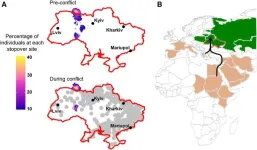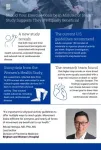(Press-News.org) A new study conducted by the Wilhelm Lab at the University of Oklahoma examines a promising development in biomedical nanoengineering. Published in Advanced Materials, the study explores new findings on the transportation of cancer nanomedicines into solid tumors.
A frequent misconception about many malignant solid tumors is that they are comprised only of cancerous cells. However, solid tumors also include healthy cells, such as immune cells and blood vessels. These blood vessels are nutrient transportation highways that tumors need to grow, but they can also be a pathway for medicine delivery, including for cancer nanomedicines.
Blood vessels, and the endothelial cells within them, are the transportation method examined in the new study led by Lin Wang, Ph.D., who was a postdoctoral research associate in the Wilhelm Lab while conducting the study and is the first author of the publication. Endothelial cells line blood vessels and manage the exchange between the bloodstream and surrounding tissues. These cells are the first barrier that the nanotechnologies encounter in the process of being transported into tumors. The researchers found that endothelial cells in breast cancer tumors are two times more likely to interact with medicine-carrying nanoparticles than endothelial cells in healthy breast tissue. Wang said that the tumor endothelial cells have more transport features than the healthy endothelial cells, making them ideal conduits.
“If you know that the same cell type in tumor tissues is two times more likely to interact with your drug carriers than in healthy tissue, then in theory, you should be able to target those cells to get even more nanoparticles delivered into the tumor,” said Stefan Wilhelm, Ph.D., associate professor in the Stephenson School of Biomedical Engineering and corresponding author of the study.
The research was conducted on endothelial cells isolated from breast cancer tissues and isolated from healthy breast tissues. The next steps for the research will involve examining how the nanoparticles react in the context of the whole tissue architecture.
“Cell-culture level experiments are only so good in trying to recapitulate what is happening in the body,” said Wilhelm. “Working with colleagues at OU Health Sciences, we hope to get our hands on not just cells but the entire tumor tissue.”
The research team is working with the Stephenson Cancer Center to set up an ethics protocol allowing the lab to access stored samples of cancer tissue rather than just isolated cells. The Wilhelm Lab is focused on studying nanomedicine and using nanoparticles for drug delivery and diagnostics. In particular, the team is interested in studying the delivery of drugs into solid tumor tissues. From an engineering perspective, a unique advantage of using nanoparticles for drug delivery is that they are small and flexible enough to be designed as direct delivery vehicles. In a laboratory setting, the nanoparticles are often designed as tiny spheres and loaded with the necessary drugs. Then, in clinics, they are often administered intravenously to patients. These drugs circulate through the bloodstream, and some of them enter the tumor.
There are challenges associated with this type of medicine transportation. One is that these nanoparticles circulate throughout the body, and consequently, they accumulate in other organs—called off-target organs—such as the liver, spleen and kidneys. Since these organs filter blood, they remove the nanoparticles, which are often considered foreign objects by the body.
The field of nanomedicine has been around for more than 40 years, and there are tens of thousands of publications on using nanoparticles to treat cancers at the preclinical stage. But there is a disconnect between the number of preclinical publications and the number of FDA-approved formulations of nanoparticles that are actually used in clinics. Of those approved formulations, a fraction are used for solid tumors, and most treat liquid tumors, such as leukemia. Wilhelm speculates that this is partially because there is a lack of full understanding of how the nanoparticle delivery process works. “And if you don’t understand something fully, it’s hard to develop solutions to those problems,” said Wilhelm.
“Researchers have started to go back to the fundamentals of nanomedicine development to understand the translation from the pre-clinical to the clinical space. Our lab wants to focus on these fundamentals to better understand the field and the delivery mechanisms specifically. If we understand these fundamentals we can contribute even more to the field,” said Wang.
According to Wilhelm, the next big question is this: now that the lab has quantified and shown that endothelial cells are more likely to interact with and transport these nanomedicines, how can that transportation be made more efficient and specific to advance clinical cancer treatments? As these questions are answered, the opportunities for future advances in cancer health care will grow.
“We are just scratching the surface by using breast cancer as our model cancer system, but our findings may be relevant for other types of solid tumors as well,” said Wilhelm.
END
Study reveals promising development in cancer-fighting nanotechnologies
The new study could lead to advances in fighting solid tissue tumors.
2024-05-20
ELSE PRESS RELEASES FROM THIS DATE:
Fat cells influence heart health in Chagas disease
2024-05-20
Jyothi Nagajyothi, Ph.D. and her laboratory at the Hackensack Meridian Center for Discovery and Innovation (CDI) have identified what may be the main mechanism for how chronic Chagas Disease, a parasitic infection affecting millions of people worldwide, can cause irreversible and potentially fatal heart damage.
The culprit is in the adipose (fat tissue) which the parasite Trypanosoma cruzi destroys in the course of infection, releasing smaller particles which induce the dysfunction of heart tissue, conclude the scientists in the journal iScience, a Cell Press open-access journal.
“We are attempting to understand this ...
C-Path’s TRxA announces its first biologics-focused RFP for academic investigators
2024-05-20
TUCSON, Ariz, May 20, 2024 – Critical Path Institute’s (C-Path) Translational Therapeutics Accelerator (TRxA) today announced its inaugural biologics-focused Request for Proposals (RFP) in its Bridging Research and Innovation in Drug Development Grants program (BioBRIDGe). BioBRIDGe awards are designed to help academic researchers traverse the drug development valley of death by providing funding and defining optimal strategies for advancing new, cutting-edge protein-based therapeutics (PBT) from the lab to patients.
For this funding cycle, ...
Enhancing superconductivity of graphene-calcium superconductors
2024-05-20
Superconductors are materials that can conduct electricity with zero resistance when they are cooled below a certain critical temperature. They have applications in several fields, including magnetic resonance imaging, particle accelerators, electric power, and quantum computing. However, their widespread use is limited by the need for extremely low temperatures. Graphene-based materials are promising for superconductors due to their unique properties such as optical transparency, mechanical strength, and flexibility. Graphene is a single layer of carbon (C) atoms arranged in a two-dimensional honeycomb structure. Among these materials, ...
Federal Trade Commission actions on prescription drugs, 2000-2022
2024-05-20
About The Study: The Federal Trade Commission (FTC) brought about one enforcement action and three merger actions per year against pharmaceutical manufacturers from 2000-2022, pursuing a small fraction of the estimated misconduct and consolidation in the pharmaceutical marketplace. Although the FTC faces substantial legal and practical limitations, important tools remain untested, including a rule defining “unfair methods of competition,” that may allow it to more effectively prevent repetitive patterns of anticompetitive behavior.
Corresponding Author: To contact the corresponding author, Aaron S. Kesselheim, ...
Fluoride exposure during pregnancy linked to increased risk of childhood neurobehavioral problems, study finds
2024-05-20
Nearly three-quarters of the United States population receives drinking water that contains fluoride, a practice that began in 1945 to help prevent tooth decay. But recent studies suggest that fluoride exposure can cause harm to a fetus if consumed during pregnancy, a critical period for brain development.
A new study, led by researchers at the Keck School of Medicine of USC and funded in part by the National Institutes of Health, analyzed more than 220 mother-child pairs, collecting data on fluoride levels during pregnancy and child behavior at age three. The researchers found that a 0.68 milligram per ...
The Ukraine war caused migrating eagles to deviate from their usual flight plan
2024-05-20
When migrating through Ukraine in 2022, Greater Spotted Eagles were exposed to multiple conflict events that altered their migratory course, according to a study reported on May 20 in the journal Current Biology. Greater Spotted Eagles are large raptors that are classified as a vulnerable species by the International Union for Conservation of Nature (IUCN).
“Armed conflicts can have wide-ranging impacts on the environment, including changes in animal behavior,” says Charlie Russell (@CJG_Russell) of the University of East Anglia, UK. “Our ...
Endangered migrating eagles impacted by Ukraine war
2024-05-20
A new study reveals for the first time the impact of ongoing conflicts on the migration of an endangered bird species.
Researchers from the University of East Anglia (UEA), the British Trust for Ornithology (BTO) and the Estonian University of Life Sciences compared the movement and migration of the Greater Spotted Eagle through Ukraine, before and shortly after it was invaded by Russia in February 2022.
They were already studying the species when the war started, with the dangers faced by migratory birds usually related to disruptive weather or drought, changes in land use affecting traditional stopping-off ...
Study explores association between fluoride exposure in pregnancy and neurobehavioral issues in young children
2024-05-20
Higher fluoride levels in pregnant women are linked to increased odds of their children exhibiting neurobehavioral problems at age 3, according to a new study led by a University of Florida College of Public Health and Health Professions researcher.
The findings, based on an analysis involving 229 mother-child pairs living in a U.S. community with typical fluoride exposure levels for pregnant women in fluoridated regions in North America, appear May 20 in the journal JAMA Network Open. It is believed to be the first U.S.-based study to examine associations of prenatal fluoride exposure ...
Using magnetic resonance spectroscopy to design safer, higher-performance lithium batteries
2024-05-20
Columbia Engineers use nuclear magnetic resonance spectroscopy to examine lithium metal batteries through a new lens -- their findings may help them design new electrolytes and anode surfaces for high-performance batteries
New York, NY—May 20, 2024—A Columbia Engineering team has published a paper in the journal Joule today that details how nuclear magnetic resonance spectroscopy techniques can be leveraged to design the anode surface in lithium metal batteries. The researchers also present new data and interpretations for how this method can be used to gain unique insight into the structure of these surfaces to share with the field.
“We ...
Should your exercise goals be in minutes or steps? Study suggests they are equally beneficial
2024-05-20
In the age of smartwatches, monitoring step counts has never been easier, but current physical activity guidelines do not explicitly recommend specific step counts for health. A new study from researchers at Brigham and Women’s Hospital, a founding member of Mass General Brigham, suggests that both step and time-based exercise targets are equivalently associated with lower risks of early death and cardiovascular disease. Thus, whether one chooses a time or step goal may not be as important as choosing a goal aligned with personal preferences. Results are published in JAMA Internal Medicine.
Physical activity reduces the risk of acquiring chronic illness and ...
LAST 30 PRESS RELEASES:
House sparrows in northern Norway can help us save other endangered animals
Crohn's & Colitis Foundation survey reveals more than 1/3 of young adults with IBD face step therapy insurance barriers
Tethered UAV autonomous knotting on environmental structures for transport
Decentralized social media platforms unlock authentic consumer feedback
American Pediatric Society announces Vanderbilt University School of Medicine as host institution for APS Howland Visiting Professor Program
Scientists discover first method to safely back up quantum information
A role for orange pigments in birds and human redheads
Pathways to net-zero greenhouse gas emissions for Southeast Asia
A JBNU–KIMS collaborative study on a cost-effective alloy matches superalloys for power plants and energy infrastructure
New study overturns long-held model of how plants coordinate immune responses.
New AI model predicts disease risk while you sleep
Scientists discover molecular ‘reshuffle’ and crack an 80-year-old conundrum
How stressors during pregnancy impact the developing fetal brain
Electrons lag behind the nucleus
From fungi to brain cells: one scientist's winding path reveals how epigenomics shapes neural destiny
Schizophrenia and osteoporosis share 195 genetic loci, highlighting unexpected biological bridges between brain and bone
Schizophrenia-linked genetic variant renders key brain receptor completely unresponsive to both natural and therapeutic compounds
Innovative review reveals overlooked complexity in cellular energy sensor's dual roles in Alzheimer's disease
Autism research reframed: Why heterogeneity is the data, not the noise
Brazil's genetic treasure trove: supercentenarians reveal secrets of extreme human longevity
The (metabolic) cost of life
CFRI special issue call for papers: New Frontiers in Sustainable Finance
HKU Engineering scholar demonstrates the smallest all-printed infrared photodetectors to date
Precision empowerment for brain "eavesdropping": CAS team develops triple-electrode integrated functional electrode for simultaneous monitoring of neural signals and chemical transmitters during sleep
Single-capillary endothelial dysfunction resolved by optoacoustic mesoscopy
HKU three research projects named among ‘Top 10 Innovation & Technology News in Hong Kong 2025’ showcasing excellence in research and technology transfer
NLRSeek: A reannotation-based pipeline for mining missing NLR genes in sequenced genomes
A strand and whole genome duplication–aware collinear gene identification tool
Light storage in light cages: A revolutionary approach to on-chip quantum memories
Point spread function decoupling in computational fluorescence microscopy
[Press-News.org] Study reveals promising development in cancer-fighting nanotechnologiesThe new study could lead to advances in fighting solid tissue tumors.






